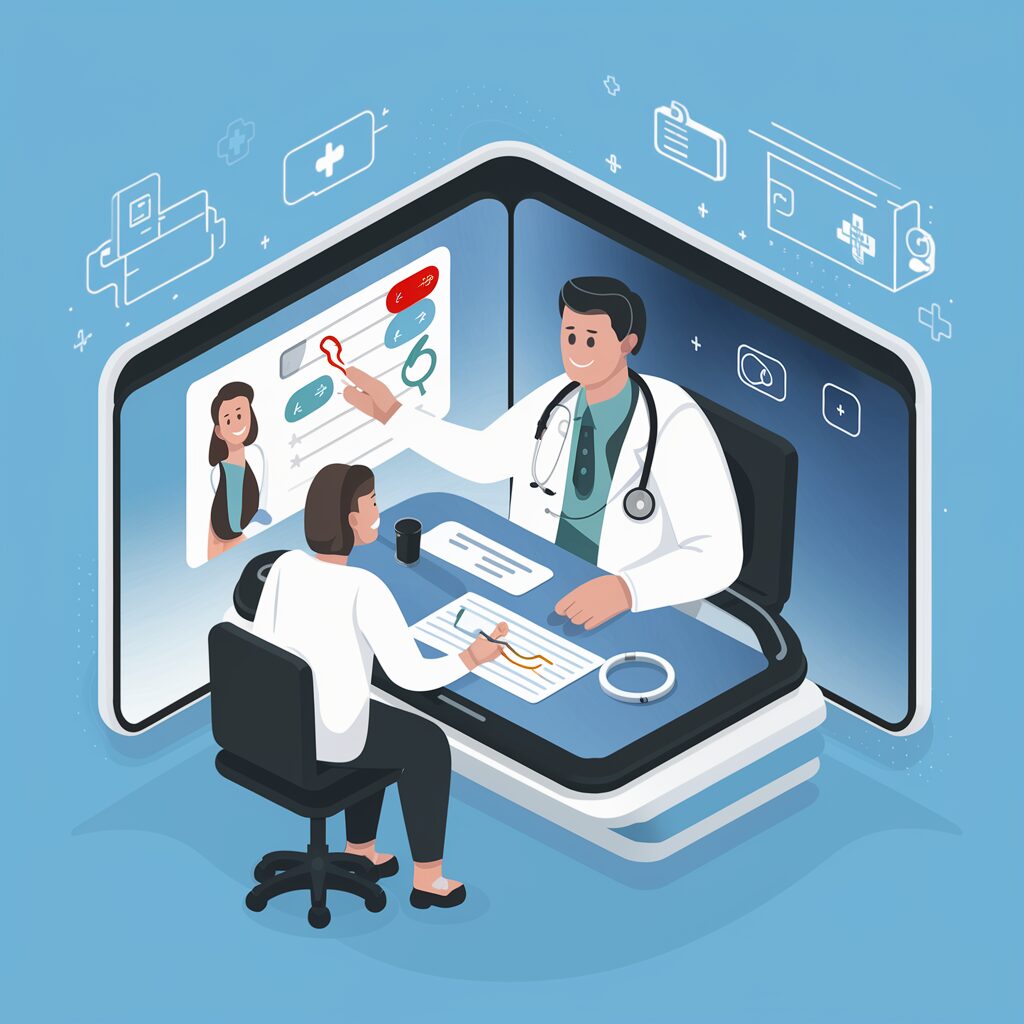Telemedicine and Remote Care in 2024: A Connected Future for Health
Contents
- 1 Telemedicine and Remote Care in 2024: A Connected Future for Health
- 1.1 Introduction
- 1.2 Trends Shaping a Connected Future
- 1.3 Remote Patient Monitoring on the Rise
- 1.4 Policy Evolution and Insurance Coverage: Paving the Way
- 1.5 read more posts
- 1.6 Technological Advancements: The Connected Healthcare Ecosystem
- 1.7 read more posts
- 1.8 Challenges and Considerations: Building a Secure Future
- 1.9 read more posts
- 1.10 The Road Ahead: A Future of Connected Care
- 1.11 read more posts
- 1.12 Looking beyond 2024
- 1.13 read more posts
- 1.14 Conclusion:
- 1.15 read more posts
- 1.16 FAQs with Answers:
- 1.17 read more posts
Read DISCLAIMER
Discover the transformative impact of telemedicine and remote care in 2024. Explore key trends, challenges, and advancements shaping the future of healthcare delivery, from increased accessibility and AI integration to policy reforms and RPM adoption.
Introduction
In 2024, telemedicine and remote care have evolved from being perceived as temporary solutions necessitated by the COVID-19 pandemic to becoming integral components of the healthcare landscape. Initially, these technologies were adopted out of necessity to maintain patient care while minimizing physical contact and reducing the risk of virus transmission. However, as time has progressed, their significance has become increasingly evident, leading to a fundamental shift in how healthcare services are delivered.

This blog aims to explore the significant developments and trends that have propelled telemedicine and remote care into the forefront of healthcare delivery. From technological advancements to policy reforms, various factors have contributed to the growing acceptance and integration of remote healthcare solutions. By delving into these key trends and challenges, we can gain a deeper understanding of the transformative impact of telemedicine on the future of healthcare.
Trends Shaping a Connected Future
In the realm of telemedicine and remote care, several prominent trends are shaping the landscape, paving the way for a more connected and inclusive future in healthcare.
1. Accessibility for All :
Telemedicine is breaking down geographical barriers, ensuring that healthcare services are accessible to all, regardless of location or mobility constraints. Through the utilization of digital communication technologies, such as mobile healthcare solutions developed by companies like Devabit, individuals in remote or underserved areas can now access medical consultations and services with ease. This newfound accessibility is fostering a more inclusive healthcare environment, ensuring that no one is left behind in receiving the care they need.
2. Specialty Spotlight :
Virtual consultations are no longer limited to general practitioners. Instead, they are becoming increasingly common across a wide range of medical specialties. Telehealth platforms are empowering patients to connect with specialists in dermatology, mental health, and chronic disease management remotely. This expansion of virtual specialty care not only enhances access to specialized expertise but also provides patients with greater convenience and flexibility in managing their health conditions.

3. AI Integration:
The Power of Prediction : Artificial intelligence (AI) is revolutionizing telecare by enabling predictive analytics and machine learning (ML) algorithms to drive personalized patient care. These healthcare IT advancements are capable of analyzing vast amounts of patient data to identify potential health risks proactively, allowing healthcare providers to intervene early and prevent adverse outcomes. Moreover, AI-powered healthcare virtual assistants (HVAs), leveraging Natural Language Processing (NLP), are emerging as valuable tools for improving patient engagement and self-management. By harnessing the power of AI, telemedicine is poised to deliver more efficient, effective, and personalized care experiences for patients worldwide.
Remote Patient Monitoring on the Rise
In 2024, Remote Patient Monitoring (RPM) has emerged as a pivotal trend in the healthcare industry, gaining recognition from top executives, including C-suite leaders. These leaders are increasingly acknowledging the significant benefits that RPM offers in managing a range of chronic conditions, such as heart disease, diabetes, and chronic respiratory illnesses.
One of the primary advantages of RPM is its ability to provide continuous monitoring of patients’ health metrics and vital signs remotely. By utilizing wearable devices and other connected health technologies, RPM enables healthcare providers to track patients’ health data in real-time, even when they are not physically present in a clinical setting. This continuous monitoring allows for early detection of any changes or abnormalities in patients’ health status, facilitating timely interventions and preventive measures.
Solutions like hospital-at-home programs and post-operative remote monitoring are particularly noteworthy applications of RPM. Hospital-at-home programs offer an alternative to traditional in-patient care by allowing patients to receive medical attention and monitoring in the comfort of their own homes. This not only reduces the strain on healthcare facilities but also improves patient satisfaction and outcomes. Similarly, post-operative remote monitoring allows healthcare providers to monitor patients’ recovery progress remotely, minimizing the need for frequent hospital visits and reducing the risk of complications.

For the geriatric population and individuals with chronic conditions, RPM holds immense promise in improving patient outcomes and quality of life. By providing continuous monitoring and timely interventions, RPM helps to prevent exacerbations of chronic conditions, reduce hospitalizations, and enhance overall health and well-being.
Furthermore, RPM solutions have been shown to be cost-effective, offering significant savings in healthcare expenditures by reducing the need for hospitalizations and emergency department visits. This makes RPM an attractive option for healthcare organizations seeking to optimize resources and improve efficiency in care delivery.
Policy Evolution and Insurance Coverage: Paving the Way
In 2024, policy evolution and insurance coverage play crucial roles in driving the widespread adoption of telemedicine. Government policies and initiatives are instrumental in shaping the regulatory framework and reimbursement structures that govern telehealth services. Here’s an in-depth look at the factors contributing to policy evolution and expanded insurance coverage:
1. Government Prioritization of Health Equity :
There is a growing recognition among government agencies of the importance of ensuring health equity and access to care for all individuals, regardless of their geographical location or socioeconomic status. Policies aimed at promoting health equity often include provisions to support telemedicine initiatives, as they have the potential to bridge gaps in healthcare access and improve health outcomes for underserved populations.
2. Initiatives by Centers for Medicaid and Medicaid Services (CMS) :
CMS plays a significant role in shaping telemedicine policies, particularly concerning reimbursement for telehealth services. In recent years, CMS has implemented several initiatives to expand coverage for telemedicine, including reimbursing Federally Qualified Health Centers (FQHCs) for telehealth visits. By providing financial incentives and support to FQHCs, CMS aims to increase access to telemedicine services for Medicare and Medicaid beneficiaries, particularly those in rural and underserved areas.
3. Expanded Coverage by Private Insurers :
In addition to government initiatives, private insurers are increasingly recognizing the value of telemedicine in improving healthcare access and reducing costs. Many private insurers have expanded coverage for telehealth services, including virtual consultations and remote monitoring, as part of their benefit packages. This expanded coverage not only benefits patients by providing greater access to care but also incentivizes healthcare providers to offer telemedicine services as part of their practice.

4. Medicare Reimbursements and New CPT Codes :
Medicare reimbursements are a significant driver of telemedicine adoption among healthcare providers, as they directly impact the financial viability of telehealth programs. In response to the growing demand for telemedicine services, Medicare has expanded reimbursement options and created new Current Procedural Terminology (CPT®) codes specifically for telehealth services. These reimbursement changes make it financially feasible for healthcare providers to offer telemedicine consultations and services, leading to increased adoption and utilization of telehealth technologies.
read more posts
Technological Advancements: The Connected Healthcare Ecosystem
In the landscape of telemedicine, technological advancements are driving significant changes, shaping a connected healthcare ecosystem that revolutionizes patient care delivery. Here’s a deeper dive into the role of innovation and the integration of advanced healthcare technology systems:
1. Integration with Healthcare Technology Systems :
Telemedicine is increasingly integrating with existing healthcare technology systems, particularly Electronic Health Records (EHRs). This integration streamlines data management and care coordination by enabling seamless sharing of patient information between healthcare providers, regardless of their location. By accessing patient data through EHRs, telemedicine practitioners can make informed decisions and provide high-quality care, enhancing patient outcomes and satisfaction.
2. 21st Century Cures Act and Connected Health Devices :
The 21st Century Cures Act has catalyzed the adoption of connected health devices, such as wearables and remote monitoring tools, in telemedicine practices. These devices, including smartwatches (e.g., Apple Watch), fitness trackers (e.g., Fitbit Sense), and upcoming innovations like the Google Pixel Watch, enable remote data collection and monitoring of various health metrics. Blood pressure cuffs from brands like Omron and Withings, EKG monitors like KardiaMobile and AliveCor, as well as pulse oximeters and continuous glucose monitors (CGMs) such as Dexcom, are among the devices facilitating remote health monitoring.
3. Continuous Data Collection for Remote Monitoring :
These connected health devices collect a wealth of continuous data on vital signs, including body temperature, heart rate, respiratory rate, and other relevant health metrics. By leveraging these data streams, healthcare providers can gain real-time insights into patients’ health status, allowing for early detection of potential issues and proactive interventions. This continuous monitoring approach enhances the quality of care and empowers patients to take an active role in managing their health.
read more posts
Challenges and Considerations: Building a Secure Future
In the pursuit of a secure future for telemedicine, there are several challenges and considerations that need to be addressed. Despite the significant progress made in the field, several obstacles continue to hinder the widespread adoption and implementation of telemedicine solutions:
1. Reimbursement Barriers :
One of the primary challenges facing telemedicine adoption is reimbursement barriers. While there have been policy reforms and changes in reimbursement structures to incentivize telehealth services, disparities still exist in reimbursement rates and coverage across different payers. Healthcare providers may hesitate to invest in telemedicine infrastructure if they are uncertain about the financial viability of these services.
2. Provider Shortages :
Another challenge is the shortage of healthcare providers, particularly in certain specialties and underserved areas. Telemedicine has the potential to bridge this gap by enabling remote consultations and expanding access to care. However, the shortage of providers can still pose challenges in delivering timely and comprehensive healthcare services through telemedicine platforms.

3. Data Privacy Concerns :
Data privacy and security concerns are paramount in telemedicine, as the transmission and storage of sensitive patient information occur over digital platforms. Ensuring compliance with regulations such as HIPAA (Health Insurance Portability and Accountability Act) is essential to protect patient privacy and maintain trust in telemedicine services. Data breaches and unauthorized access to patient information can have severe consequences and undermine the credibility of telemedicine platforms.
4. User-Friendly Technology Adoption :
The successful adoption of telemedicine hinges on the usability and accessibility of technology platforms for both healthcare providers and patients. User-friendly interfaces, intuitive design, and seamless integration with existing workflows are critical factors in driving adoption and acceptance of telemedicine solutions. Overcoming technological barriers and ensuring that telemedicine platforms are accessible to individuals with varying levels of digital literacy is essential for realizing the full potential of remote healthcare delivery.
To address these challenges, concerted efforts are needed from various stakeholders in the healthcare ecosystem:
– Physician Buy-in : Healthcare providers play a central role in the adoption and implementation of telemedicine. Physician buy-in and engagement are essential for the successful integration of telemedicine into clinical practice. Providing training and support to healthcare professionals to familiarize them with telemedicine platforms and workflows can facilitate greater acceptance and participation.
– Policy Reforms : Policy reforms at the local, state, and federal levels are necessary to address reimbursement disparities, licensure requirements, and regulatory barriers that hinder telemedicine adoption. Advocating for policy changes that promote telemedicine reimbursement parity, licensure reciprocity, and streamlined regulatory frameworks can facilitate the expansion of telehealth services and improve access to care for patients.
– Public-Private Partnerships : Collaboration between government agencies, healthcare organizations, technology companies, and other stakeholders is essential for overcoming the challenges facing telemedicine. Public-private partnerships can drive innovation, leverage resources, and foster the development of sustainable telemedicine solutions that address the needs of diverse patient populations.
read more posts
The Road Ahead: A Future of Connected Care
In 2024, the trajectory of telemedicine and remote care is poised for rapid advancement, reshaping the landscape of healthcare delivery. Forward-thinking healthcare organizations, in collaboration with innovative telehealth platforms such as Consagous Technologies and Healthcare IT specialists identified on platforms like Goodfirms, are at the forefront of this transformation. Together, they are driving initiatives aimed at creating a future characterized by accessible, efficient, and patient-centered care.
These organizations recognize the potential of telemedicine to revolutionize healthcare delivery by leveraging digital technologies to overcome traditional barriers to access and improve the quality of care. By partnering with leading telehealth platforms like Consagous Technologies, healthcare organizations gain access to cutting-edge solutions and expertise that enable them to enhance their telemedicine offerings and reach a broader patient base.
Similarly, leveraging the expertise of Healthcare IT specialists identified on platforms like Goodfirms, healthcare organizations can navigate the complexities of implementing and optimizing telemedicine solutions. These specialists provide valuable insights and support in areas such as system integration, data management, and cybersecurity, ensuring that telemedicine programs are both effective and secure.
By embracing these advancements and addressing existing challenges, healthcare organizations can ensure that telemedicine continues to drive positive change in healthcare delivery. Through telemedicine, healthcare becomes more accessible to all individuals, regardless of geographical location or socioeconomic status. This fosters a global reach that not only tackles healthcare disparities but also creates a more equitable healthcare landscape.
read more posts
Looking beyond 2024
As we look beyond 2024, the future of telemedicine appears increasingly promising, with continued advancements and innovations reshaping the healthcare landscape. One of the key developments anticipated in the coming years is the widespread adoption of hybrid care models, which seamlessly integrate virtual and in-person visits. These hybrid models offer patients greater flexibility and convenience in accessing healthcare services, allowing them to choose the most suitable mode of care based on their preferences and needs.
Moreover, telehealth advancements in specialized areas such as tele-ICU, telestroke, teledermatology, telerehabilitation, and even tele-surgery are expected to gain traction, further expanding access to specialized services. Tele-ICU allows remote monitoring and management of intensive care patients, while telestroke facilitates rapid assessment and treatment of stroke patients in underserved areas. Teledermatology enables dermatological consultations and assessments remotely, while telerehabilitation provides rehabilitation services to patients recovering from injuries or surgeries. Additionally, tele-surgery enables surgeons to perform procedures remotely, leveraging advanced robotic technologies.
Continuous technological advancements will play a crucial role in driving the evolution of telemedicine. Improved data security and privacy measures will address concerns surrounding the protection of patient information, ensuring compliance with regulations such as HIPAA. Enhanced interoperability and integration with existing healthcare systems will enable seamless communication and data sharing between different healthcare providers and platforms, facilitating better coordination of care and improved patient outcomes.
Furthermore, ongoing policy evolution will continue to shape the regulatory landscape surrounding telemedicine, fostering an environment conducive to its expansion and adoption. Policies aimed at promoting reimbursement parity, licensure reciprocity, and regulatory flexibility will support the growth of telemedicine and encourage greater participation from healthcare providers and organizations.
read more posts
Conclusion:
In conclusion, the year 2024 marks a significant milestone in the evolution of telemedicine and remote care, transforming them from temporary solutions into integral components of the healthcare landscape. Through technological advancements, policy reforms, and collaborative efforts among stakeholders, telemedicine has become a catalyst for accessible, efficient, and patient-centered healthcare delivery.
The trends shaping telemedicine in 2024, including increased accessibility, expanded specialty services, AI integration, and RPM adoption, reflect a growing recognition of the potential of remote healthcare solutions to improve patient outcomes and address healthcare disparities. These trends underscore the transformative impact of telemedicine on the future of healthcare, promising a connected and inclusive healthcare ecosystem.
However, challenges such as reimbursement barriers, provider shortages, and data privacy concerns remain significant hurdles that must be addressed to fully realize the potential of telemedicine. By fostering physician buy-in, advocating for policy reforms, and leveraging public-private partnerships, stakeholders can overcome these challenges and build a secure future for telemedicine.
Looking beyond 2024, the future of telemedicine holds even greater promise, with hybrid care models, specialized telehealth services, and continuous technological advancements driving further innovation in healthcare delivery. With ongoing policy evolution, enhanced data security measures, and collaboration across the healthcare ecosystem, telemedicine is poised to revolutionize healthcare on a global scale, creating a more equitable and accessible healthcare landscape for all.
read more posts
FAQs with Answers:
1. What is telemedicine?
– Telemedicine refers to the remote delivery of healthcare services using telecommunications technology, allowing patients to consult with healthcare providers remotely.
2. How has telemedicine evolved in 2024?
– In 2024, telemedicine has evolved from a temporary solution to a permanent fixture in healthcare, driven by technological advancements, policy reforms, and increased acceptance among healthcare providers and patients.
3. What are some key trends shaping telemedicine in 2024?
– Key trends in telemedicine include increased accessibility, expanded specialty services, AI integration, RPM adoption, and policy reforms promoting reimbursement parity and expanded coverage.
4. What role does AI play in telemedicine?
– AI enables predictive analytics, personalized care plans, and healthcare virtual assistants, enhancing patient care and engagement in telemedicine.
5. How does RPM benefit patients?
– RPM allows for continuous monitoring of patients’ health metrics remotely, facilitating early detection of health issues and proactive interventions, particularly for chronic conditions.
6. What policy changes have influenced telemedicine adoption?
– Government prioritization of health equity, CMS initiatives to expand coverage, and expanded private insurance coverage have all contributed to the widespread adoption of telemedicine.
7. How are technological advancements shaping telemedicine?
– Integration with EHRs, adoption of connected health devices, and continuous data collection for remote monitoring are driving advancements in telemedicine technology.
8. What are some challenges facing telemedicine adoption?
– Challenges include reimbursement barriers, provider shortages, data privacy concerns, and ensuring user-friendly technology adoption.
9. How can stakeholders address challenges in telemedicine adoption?
– Stakeholders can address challenges through physician buy-in, policy reforms, public-private partnerships, and advancements in technology and infrastructure.
10. What is the outlook for telemedicine beyond 2024?
– Beyond 2024, telemedicine is expected to continue evolving, with hybrid care models, specialized telehealth services, and ongoing technological advancements driving further innovation in healthcare delivery.
read more posts

One thing I would really like to comment on is that fat burning plan fast can be achieved by the right diet and exercise. Ones size not only affects the look, but also the actual quality of life. Self-esteem, depressive disorders, health risks, as well as physical skills are damaged in extra weight. It is possible to just make everything right and at the same time having a gain. Should this happen, a problem may be the offender. While excessive food and not enough exercise are usually at fault, common health conditions and widely used prescriptions may greatly enhance size. I am grateful for your post in this article.
I am not sure where you’re getting your information, but good topic. I needs to spend some time learning much more or understanding more. Thanks for great info I was looking for this info for my mission.
Hello There. I found your blog using msn. That is a very smartly written article. I抣l be sure to bookmark it and return to read more of your helpful info. Thanks for the post. I will definitely comeback.
Hi there, You’ve performed a great job. I抣l definitely digg it and in my view recommend to my friends. I am confident they’ll be benefited from this site.
Oh my goodness! an incredible article dude. Thanks However I’m experiencing situation with ur rss . Don抰 know why Unable to subscribe to it. Is there anyone getting equivalent rss drawback? Anybody who knows kindly respond. Thnkx
You made some decent points there. I looked on the internet for the difficulty and located most individuals will go together with along with your website.
Thanks for another wonderful article. Where else may anybody get that kind of info in such a perfect manner of writing? I have a presentation subsequent week, and I am at the look for such information.
I have seen a great deal of useful elements on your internet site about personal computers. However, I’ve got the viewpoint that notebooks are still more or less not powerful adequately to be a option if you often do things that require a lot of power, for example video modifying. But for net surfing, microsoft word processing, and a lot other common computer work they are fine, provided you never mind the screen size. Many thanks for sharing your notions.
Fascinating blog! Is your theme custom made or did you download it from somewhere? A design like yours with a few simple tweeks would really make my blog stand out. Please let me know where you got your design. Thank you
You really make it seem really easy along with your presentation but I to find this topic to be actually something that I feel I’d never understand. It sort of feels too complicated and very huge for me. I’m having a look ahead for your next post, I抣l attempt to get the grasp of it!
Excellent beat ! I would like to apprentice while you amend your site, how could i subscribe for a blog web site? The account aided me a acceptable deal. I had been a little bit acquainted of this your broadcast offered bright clear idea
I was wondering if you ever thought of changing the layout of your blog? Its very well written; I love what youve got to say. But maybe you could a little more in the way of content so people could connect with it better. Youve got an awful lot of text for only having 1 or two images. Maybe you could space it out better?
I simply could not depart your website prior to suggesting that I really enjoyed the standard info a person supply to your visitors? Is gonna be again continuously to investigate cross-check new posts
This website is known as a stroll-by for all the info you wanted about this and didn抰 know who to ask. Glimpse here, and also you抣l positively discover it.
I’ve observed that in the world the present day, video games are the latest phenomenon with children of all ages. Periodically it may be difficult to drag your children away from the video games. If you want the very best of both worlds, there are various educational activities for kids. Great post.
Thanks for the sensible critique. Me and my neighbor were just preparing to do some research on this. We got a grab a book from our area library but I think I learned more clear from this post. I am very glad to see such wonderful info being shared freely out there.
I would like to thnkx for the efforts you’ve put in writing this site. I am hoping the same high-grade web site post from you in the upcoming as well. Actually your creative writing skills has encouraged me to get my own site now. Really the blogging is spreading its wings quickly. Your write up is a good example of it.
I’m thoroughly captivated by the deep insights and excellent ability to convey information. Your expertise is evident in every piece you write. It’s clear that you spend considerable time into understanding your topics, and the results does not go unnoticed. Thank you for sharing this valuable knowledge. Continue the excellent job! https://rochellemaize.com
I like this web blog it’s a master piece! Glad I detected this on google.?